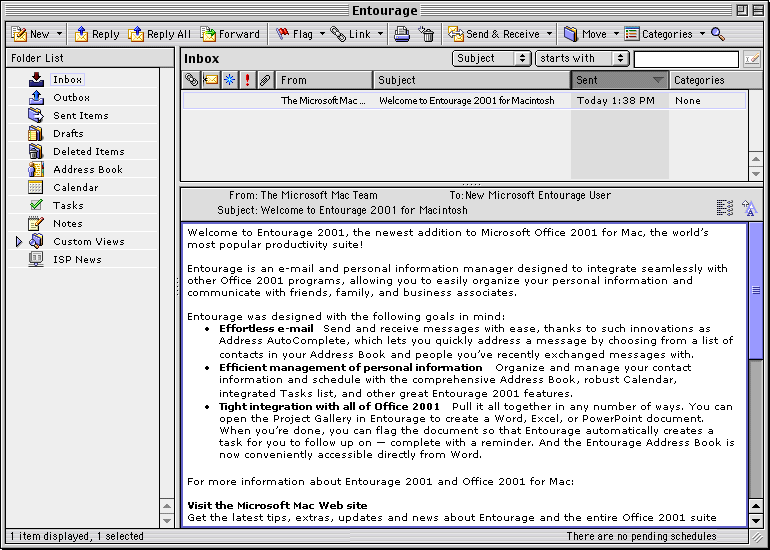Microsoft Office includes multiple applications; each designed to accomplish a specific task. Although each application operates independently of the others, all are designed to tightly integrate so the information you enter in one application can be shared among the others.
Starting a program (also called an application) is straightforward to do—and it’s the primary, a necessary step toward getting anything done. Because computers are often found out differently, you might not see the icons on your Desktop or the menu choices on the Programs menu.
Overview of Microsoft Office 2001 for Mac
All Mac programs use menus to pick commands and options from, but Office features a functionality called personalized menus. When the menu is first accessed, only the most common features are displayed. If you pause the mouse pointer over the most menu selection or move it down to the double arrows at rock bottom of a menu, the menu will expand to incorporate all available features for that menu.

- Click on the beginning button on the Mac Taskbar. The Start menu will appear.
- Click on Programs. The Programs menu will appear.
- Click on the Office program name (in this instance, Microsoft Word) that you simply want to start. T
The Welcome screen for the program will appear briefly before the most program window opens.
Using Shortcut Menus
Shortcut menus contain a limited number of commands. The commands you see on a shortcut menu depend upon what you’re doing at the time you open the shortcut menu.
Working with Dialog Boxes
Many selections within the menu are followed by three periods, called ellipses. Selections followed by ellipses indicate that, if you select one among these things, a panel will appear with the next group of options.
Working with Toolbars
As an exquisite time-saver, the Office applications include toolbars that include buttons to launch commonly used features. Any toolbar button functions are often accessed through a menu but may take a variety of steps to urge the feature. Using the toolbar button reduces the number of steps to 1.
Separating Toolbars
Most Office applications include two main toolbars, Standard and Formatting. By default, these two toolbars are displayed on an equivalent line and unless you’ve got a particularly large monitor screen, you can’t see all the tools.
Displaying Other Toolbars
There are a variety of other toolbars with buttons appropriate to varied tasks. you’ll display as many toolbars as you would like, but each additional toolbar you display takes room far away from your display for seeing your document.
Moving Toolbars
Other toolbars will appear as you employ certain features in Office applications. As toolbars appear on the screen, they might appear in an unsuitable location and you’ll want to move them.
Understanding SmartTags
SmartTags are new Office XP. SmartTags are small icons that appear throughout your document as you perform various tasks or enter certain sorts of text. SmartTags perform actions in Office applications that might normally require you to open other programs. SmartTag functions range from quickly adding a reputation or address from your document to an Outlook contact folder to offering options when pasting data from the Clipboard.

The appearance of SmartTags will vary counting on the function, but all of them appear as small icons near the world in question.
You might see text with purple dotted lines under it; Office recognizes that text as SmartTag text. As you progress your mouse over the text, an indicator within the sort of an icon will appear. Other times, the SmartTag will automatically appear counting on the function you used last.
Clicking on the SmartTag icon will make a menu appear from which you’ll make additional
choices. during this example, if you click on increase Contacts, a contact card from Microsoft
Outlook will appear with the name and possibly the address already entered.
Working with the Task Pane
New to Office XP is that the Task Pane. Most Office applications include the Task pane, with the exception of Outlook. Actually, each application includes several different Task panes, each of which appears as you attempt various tasks. One feature of the Task pane assists you in creating new documents, whereas another function enables you to format your document more quickly.
Changing Task Panes
By default, Office displays the New Document Task pane. The New document task pane lists common features associated with creating a replacement document. As you decide on various functions of the appliance, the Task pane will change automatically.
System Requirements of Microsoft Office 2001 for Mac
- Require CPU of PowerPC G3
- Require operating system of Mac OS X v10.2.8
- Require RAM of 256 MB
- Require free hard disk space of 450 MB
Download Microsoft Office 2001 for Mac
You can download the Microsoft Office 2001 for Mac by accessing the link below. Also, make sure that you have enough back up before you proceed with the same. There are a lot of duplicate ISO images on the market and it is best to download the same from a trusted source.





